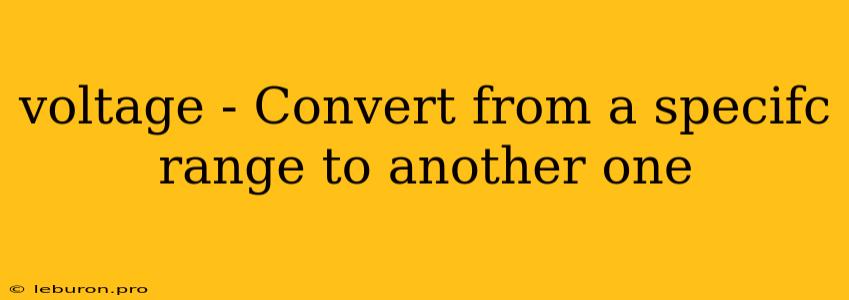Voltage conversion is a fundamental process in electronics, often required to adapt a voltage source to the specific needs of a circuit or device. This conversion process involves changing the voltage level from one range to another, typically by utilizing electronic components like transformers, voltage regulators, or voltage converters. The choice of method depends on factors such as the desired output voltage range, the input voltage source, the required power output, and efficiency considerations.
Understanding Voltage Conversion
Voltage, measured in volts (V), represents the electrical potential difference between two points. In essence, it signifies the "push" that drives electrons through a circuit. Voltage conversion is the process of altering this potential difference, either increasing or decreasing it, to meet the specific requirements of a circuit or device.
Types of Voltage Conversion:
- Step-Up Conversion: This involves increasing the voltage level. For instance, converting a 12V source to a 24V output.
- Step-Down Conversion: This involves decreasing the voltage level. For example, converting a 12V source to a 5V output.
Methods of Voltage Conversion:
1. Transformers:
Transformers are passive devices used to convert alternating current (AC) voltages. They operate on the principle of electromagnetic induction.
How it works:
- Primary Winding: The input AC voltage is applied to the primary winding of the transformer.
- Magnetic Field: The AC current in the primary winding creates a changing magnetic field.
- Secondary Winding: This changing magnetic field induces an AC voltage in the secondary winding.
- Voltage Ratio: The voltage ratio between the primary and secondary windings is determined by the number of turns in each winding.
Applications:
Transformers are widely used in power distribution systems, AC-DC converters, and other applications where AC voltage conversion is necessary.
2. Voltage Regulators:
Voltage regulators are electronic circuits designed to maintain a constant output voltage despite variations in the input voltage or load current. They are commonly used in power supplies and other circuits where a stable voltage is critical.
Types of Voltage Regulators:
- Linear Regulators: These regulators use a series pass transistor to dissipate excess voltage as heat. They are relatively simple but can be inefficient at high power levels.
- Switching Regulators: These regulators use switching elements to control the voltage output. They are generally more efficient than linear regulators and can handle higher power levels.
Applications:
Voltage regulators are essential components in power supplies, electronic devices, and automotive systems.
3. Voltage Converters:
Voltage converters are electronic circuits designed to convert DC voltage to a different DC voltage. They are available in various configurations, including:
- DC-DC Buck Converters: These converters step down the DC voltage, similar to a step-down transformer for DC.
- DC-DC Boost Converters: These converters step up the DC voltage, similar to a step-up transformer for DC.
- DC-DC Buck-Boost Converters: These converters can both step up and step down the DC voltage depending on the circuit configuration.
Applications:
DC-DC converters are widely used in portable electronic devices, computer power supplies, and automotive systems.
Choosing the Right Voltage Conversion Method:
The selection of the appropriate voltage conversion method depends on several factors, including:
- Input Voltage Source: Is the input AC or DC?
- Output Voltage Range: What is the desired output voltage level?
- Power Output: How much power is required from the output?
- Efficiency: How important is efficiency?
- Cost: What is the budget for the voltage conversion solution?
Conclusion:
Voltage conversion is a crucial aspect of electronic design, enabling the adaptation of power sources to meet specific circuit and device requirements. Understanding the various methods and their characteristics allows engineers to choose the most appropriate solution for any given application. Whether utilizing transformers, voltage regulators, or voltage converters, efficient and accurate voltage conversion is essential for the proper functioning and reliability of electronic systems.
